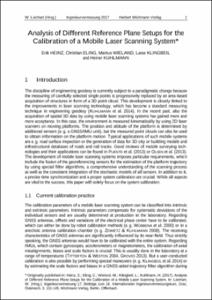Analysis of Different Reference Plane Setups for the Calibration of a Mobile Laser Scanning System

Analysis of Different Reference Plane Setups for the Calibration of a Mobile Laser Scanning System

| dc.contributor.author | Heinz, Erik | |
| dc.contributor.author | Eling, Christian | |
| dc.contributor.author | Wieland, Markus | |
| dc.contributor.author | Klingbeil, Lasse | |
| dc.contributor.author | Kuhlmann, Heiner | |
| dc.contributor.editor | Lienhart, Werner | |
| dc.date.accessioned | 2019-07-03T15:40:39Z | |
| dc.date.available | 2019-07-03T15:40:39Z | |
| dc.date.issued | 2017 | |
| dc.identifier.uri | https://hdl.handle.net/20.500.11811/1352 | |
| dc.description.abstract | The discipline of engineering geodesy is currently subject to a paradigmatic change because the measuring of carefully selected single points is progressively replaced by an area-based acquisition of structures in form of a 3D point cloud. This development is closely linked to the improvements in laser scanning technology, which has become a standard measuring technique in engineering geodesy (KUHLMANN et al. 2014). In the recent past, also the acquisition of spatial 3D data by using mobile laser scanning systems has gained more and more acceptance. In this case, the environment is measured kinematically by using 2D laser scanners on moving platforms. The position and attitude of the platform is determined by additional sensors (e. g. a GNSS/IMU unit), but the measured point clouds can also be used to obtain information on the platform motion. Typical applications of such mobile systems are e. g. road surface inspection or the generation of data for 3D city or building models and infrastructural databases of roads and rail tracks. Good reviews of mobile surveying technologies and their applications can be found in PUENTE et al. (2013) or OLSEN et al. (2013). The development of mobile laser scanning systems imposes particular requirements, which include the fusion of the georeferencing sensors for the estimation of the platform trajectory by using special filter algorithms, a comprehensive understanding of the scanning process as well as the consistent integration of the stochastic models of all sensors. In addition to it, a precise time synchronization and a proper system calibration are crucial. While all aspects are vital to the success, this paper will solely focus on the system calibration. | en |
| dc.language.iso | eng | |
| dc.rights | In Copyright | |
| dc.rights.uri | http://rightsstatements.org/vocab/InC/1.0/ | |
| dc.subject | Kinematic Laser Scanning | |
| dc.subject | Plane-Based Calibration | |
| dc.subject | Simulation | |
| dc.subject | Configuration Analysis | |
| dc.subject | Evaluation | |
| dc.subject | Accuracy | |
| dc.subject | Reliability | |
| dc.subject | Quality Criteria | |
| dc.subject.ddc | 550 Geowissenschaften | |
| dc.title | Analysis of Different Reference Plane Setups for the Calibration of a Mobile Laser Scanning System | |
| dc.type | Teil eines Buches oder einer Monografie | |
| dc.publisher.name | Herbert Wichmann Verlag | |
| dc.publisher.location | Berlin | |
| dc.rights.accessRights | openAccess | |
| dcterms.bibliographicCitation.pagestart | 131 | |
| dcterms.bibliographicCitation.pageend | 145 | |
| dc.relation.pisbn | 978-3-87907-630-7 | |
| dcterms.bibliographicCitation.booktitle | Ingenieurvermessung 17. Beiträge zum 18. Internationalen Ingenieurvermessungskurs, Graz, Österreich | |
| ulbbn.pubtype | Zweitveröffentlichung |
Dateien zu dieser Ressource
Das Dokument erscheint in:
-
Publikationen (35)




